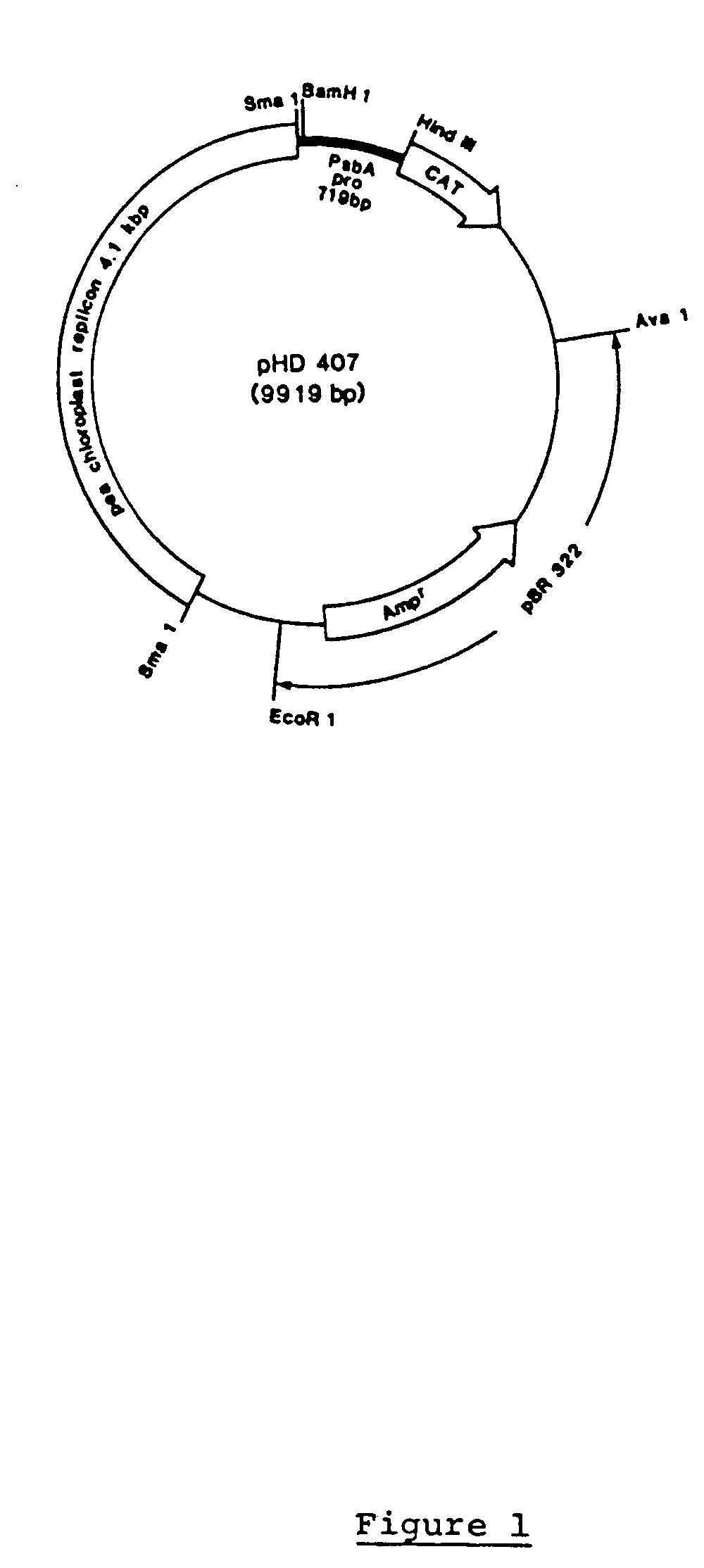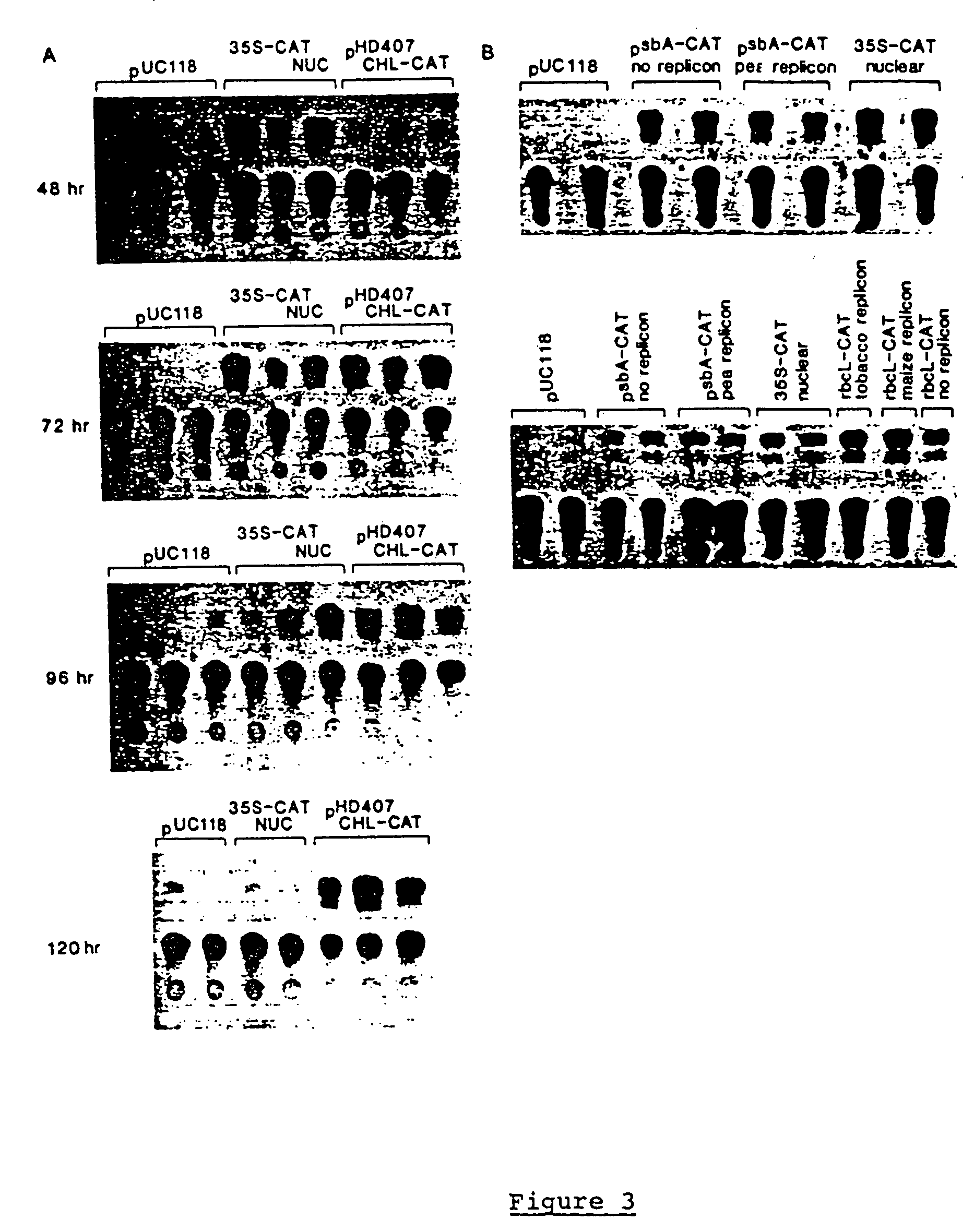Genetic engineering of plant chloroplasts
- Summary
- Abstract
- Description
- Claims
- Application Information
AI Technical Summary
Benefits of technology
Problems solved by technology
Method used
Image
Examples
example i
Transient Foreign Gene Expression in Chloroplasts of Cultured Tobacco Cells after Bolistic Delivery of Chloroplast Vectors
Construction of Chloroplast Expression Vectors
[0049]A series of chloroplast expression vectors has been constructed using the promoter selection vector pKK232-8 (Pharmacia), which is a pBR322 derivative containing a promoterless cat gene. Restriction fragments of chloroplast DNA (cpDNA) containing the entire promoter region and 5′ untranslated region of the psbA gene from spinach (pMP450, a gift from Wilhelm Gruissem, University of California, Berkeley) pHD306 or pea (pPPBX10218, a gift from John Mullet, Texas A & M University) pHD312 or, alternatively, the rbcL and atpB promoter region from maize (pPBI1443, a gift from Antony Gatenby, E.I. DuPont de Nemours & Co., Wilmington, Del.) pHD103 have been individually inserted into the multiple cloning site (MCS) that exists 5′ proximal to the promoterless cat gene. The strength of each promoter; has been investigated ...
example ii
Transient Foreign Gene Expression in Different Cellular Components of Wheat Leaves and Calli after Bolistic Delivery
Construction of the Chloroplast Expression Vector, pHD203-GUS
[0063]The chloroplast expression vector pHD203 (FIG. 6), a pBR322 derivative, contains a double psbA promoter fragment (from the pea chloroplast genome) inserted in opposite orientations to facilitate simultaneous transcription of two promoterless genes. One of the two psbA promoter regions drives the cat gene. The presence of ribosomal RNA T1 and T2 terminators distal to the cat gene aids transcription termination, while the presence of three stop codons between the psbA promoter and the AUG of the cat gene prevents translational readthrough into the cat gene. The second psbA promoter fragment has been placed upstream of a multiple cloning site (MCS) containing sites for EcoRI, AvaI, XmaI, SmaI, BamHI, SalI, HincII, PstI and HindIII. There is a ribosomal RNA Ti terminator distal to the MCS to aid transcripti...
example iii
Optimization of Delivery of Foreign DNA into Higher Plant Chloroplasts
New Biolistic Device
[0074]The standard gun-powder driven PDS-1000 biolistic device (DuPont Co.) was compared to a newly designed helium driven device. Briefly, a small chamber is sealed at one end with one or more layers of rupturable membrane (2 mil plastic membrane). The chamber is then filled to high pressure with helium gas. A solenoid-driven lance then ruptures the membrane, which releases a sharply defined shock wave. The shock wave then enters a throat region of the device which contains a removable sleeve. Inside the sleeve are removable rings which are used to retain various microprojectile launching mechanisms. The principal mechanism employed in this paper is helium entrainment. In the helium entrainment configuration, a nylon mesh is locked into place across the axis of the sleeve. Microprojectiles (in suspension) are loaded directly onto the center of the mesh, and the helium shock wave atomizes and a...
PUM
 Login to View More
Login to View More Abstract
Description
Claims
Application Information
 Login to View More
Login to View More - R&D
- Intellectual Property
- Life Sciences
- Materials
- Tech Scout
- Unparalleled Data Quality
- Higher Quality Content
- 60% Fewer Hallucinations
Browse by: Latest US Patents, China's latest patents, Technical Efficacy Thesaurus, Application Domain, Technology Topic, Popular Technical Reports.
© 2025 PatSnap. All rights reserved.Legal|Privacy policy|Modern Slavery Act Transparency Statement|Sitemap|About US| Contact US: help@patsnap.com



